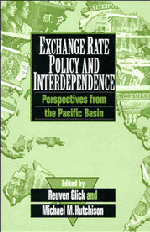Book contents
- Frontmatter
- Contents
- List of contributors
- Preface
- Exchange rate policy and interdependence
- 1 Overview
- I International financial market integration
- 2 Financial links around the Pacific Rim: 1982–1992
- 3 Relative returns on equities in Pacific Basin countries
- 4 Exchange rate policy, international capital mobility, and monetary policy instruments
- II Choice of exchange rate regimes
- III Intervention and sterilization policies
- IV Prospects for a yen bloc
- Index
3 - Relative returns on equities in Pacific Basin countries
Published online by Cambridge University Press: 04 May 2010
- Frontmatter
- Contents
- List of contributors
- Preface
- Exchange rate policy and interdependence
- 1 Overview
- I International financial market integration
- 2 Financial links around the Pacific Rim: 1982–1992
- 3 Relative returns on equities in Pacific Basin countries
- 4 Exchange rate policy, international capital mobility, and monetary policy instruments
- II Choice of exchange rate regimes
- III Intervention and sterilization policies
- IV Prospects for a yen bloc
- Index
Summary
Capital mobility
Equity markets have grown rapidly and restrictions on investments have declined equally rapidly in Pacific Basin countries in the 1980s. The return on equities now provides a good measure of the opportunity cost of capital in the eleven countries that are the focus of this study: Australia, Canada, Chile, Japan, Korea, Malaysia, Mexico, Singapore, Taiwan, Thailand, and the United States.
The purpose of equity markets is to allocate capital to its most efficient use. In the absence of uncertainty, efficient equity markets ensure that the marginal product of capital is equalized among its various uses. In the presence of uncertainty, equity markets price assets to reflect not only the expected return on the asset, but the riskiness of projects as well.
A great deal of attention has been focused in recent years on the international mobility of capital. If there are restrictions on capital flows between countries, then investors will not be able to allocate their resources toward their most desirable use. There appears to have been a global trend toward liberalization of capital markets and toward allowing foreigners access to local markets. However, there is no consensus as to whether these moves have achieved true integration of international capital markets.
Feldstein and Horioka (1980) questioned the degree of integration of international capital markets. They argued that if capital could flow freely between countries, savers would have no bias toward channeling their funds toward domestic projects.
- Type
- Chapter
- Information
- Exchange Rate Policy and InterdependencePerspectives from the Pacific Basin, pp. 48 - 67Publisher: Cambridge University PressPrint publication year: 1994



